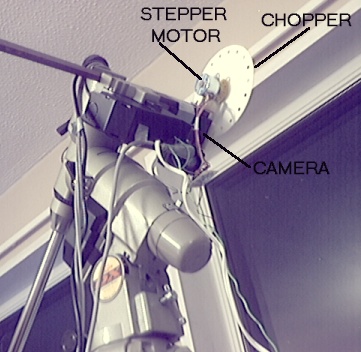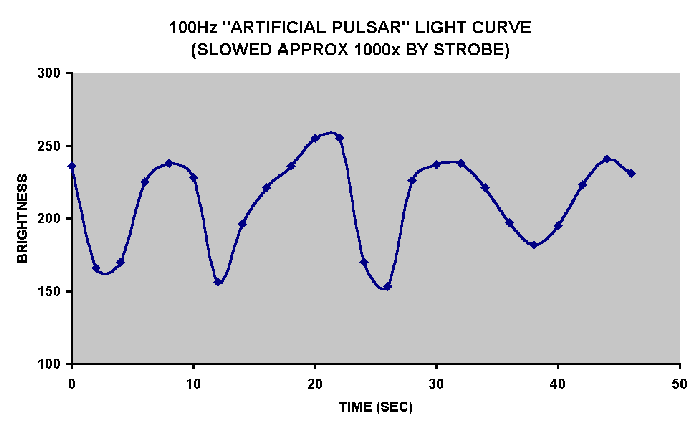
MEASURING AN OPTICAL PULSAR LIGHT CURVE
USING A STROBING TECHNIQUE
STOP PRESS 23rd MARCH 2003 SUCCESS! CLICK HERE FOR THE IMAGE
READ HOW IT WAS DONE ON THIS PAGE AND THE FOLLOWING PAGES
Feasibility study
Proposed technique
The pulsar at the heart of the Crab Nebula (M1) is mag 16 and pulsates approximately 30 times per second. To detect this pulsation directly would require an exposure time shorter than 1/60 second. Photographic film and CCD cameras are not sensitive enough to record this with amateur sized telescopes.
By mounting a chopper wheel in front of the CCD however, it is possible to sample the light from the pulsar periodically. By synchronizing the chopper frequency to the pulsar frequency and changing the relative phase, it should be possible to accumulate long exposure images which show the pulsar brightness at any given point in the light curve. If the strobe is set to a slightly different frequency eg 1 part in 3000 higher, the phase will slowly shift through one cycle in approximately 100 seconds and pulsar will appear to pulsate once every 100 seconds. This gives sufficient time to record 20 points on the pulsar light curve in a series of 5sec long exposures. My 1004x-JG camera and 200mm aperture scope should be capable of recording the mag 16 pulsar in single 5 sec frames, though several cycles may need to be recorded and stacked to give a good estimate of the light curve.
References
This technique has been used successfully on a 30 inch observatory telescope,
http://a188-l009.rit.edu/richmond/crab.html
but I have not found a reference of this being achieved using a typical amateur telescope of say 8-10 inches aperture.
I have found a reference of an attempt to observe the crab pulsar visually through a chopper wheel but it was reported as being unsuccessful
http://astro.umsystem.edu/atm/ARCHIVES/AUG99/msg00607.html
Signal/Noise ratio and exposure time
The shorter the "on" time of the chopper, the better the resolution of the light curve. A 1/3 on 2/3 off is proposed as a starting point. Because the chopper shuts off the light for part of the cycle, the amount of light reaching the CCD for a non varying star is reduced to1/3. This signal loss is compensated to some extent by a corresponding reduction in skyglow signal, but the fact remains, for a given sensitivity, a longer exposure will be required. This does not apply to the pulsar however. A normal exposure of the pulsar represents the mean brightness over the pulsar's cycle. When the chopper is in phase with the peak in light output from the pulsar, all the available light will fall on the CCD and the image will be as bright as the normal exposure. (Additionally, because the skyglow will still be 1/3 the normal level, the signal to noise will in fact be higher) Thus, the strobed pulsar image should not require any increased exposure for detection compared with the standard exposure.
Accuracy and stability of chopper frequency
The proposed technique requires that the frequency is accurate to better than say 1 part in 10000 and remains stable to this accuracy for at least 100 seconds. This in practise should not be too difficult (For comparison, it corresponds to a clock being accurate to 9 seconds per day, which is achievable with quartz crystal control) It is proposed to use a PC sound card as a frequency source. These are crystal controlled and, if kept at constant temperature, should be sufficiently stable. It may need calibrating for absolute accuracy against a known standard.
A practical demonstration system
In order to explore the practicalities of building a system, a test designed to measure the pulsing at 100Hz of a distant street lamp has been carried out. A chopper wheel with 18 holes was mounted in front of the 1004x-JG, fitted with its standard wide angle lens. The wheel was driven by a stepper motor controlled from a square wave produced by a PC card. The stepper has 48 steps per rev, so a sound card frequency of 100 * 48/18 = 266.67Hz gives a 100Hz strobing frequency. In practise, the frequency had to be adjusted between 266.2 and 267.5 to keep the strobing in line with small short term drifts in the power supply frequency to the street lamp. The set up is shown below

Although the street lamp was over 2km away, an exposure of less than 100msec was required to avoid saturation. A series of exposures were taken at 2sec intervals. The pulsing of the lamp at about a 10sec interval could be clearly seen in the resulting avi, ie the lamp pulsation had been slowed down by a factor of about 1000. The cropped image is shown as an animated gif below (speeded up)
![]()
The brightness of each frame was measured and a graph of the light curve produced (below)

The conclusion is that the principle is proved and the next step will be to make a strobe wheel to fit in the optical path of the telescope.
22nd Feb 2003
TO TELESCOPE MOUNTED STROBE DESIGN